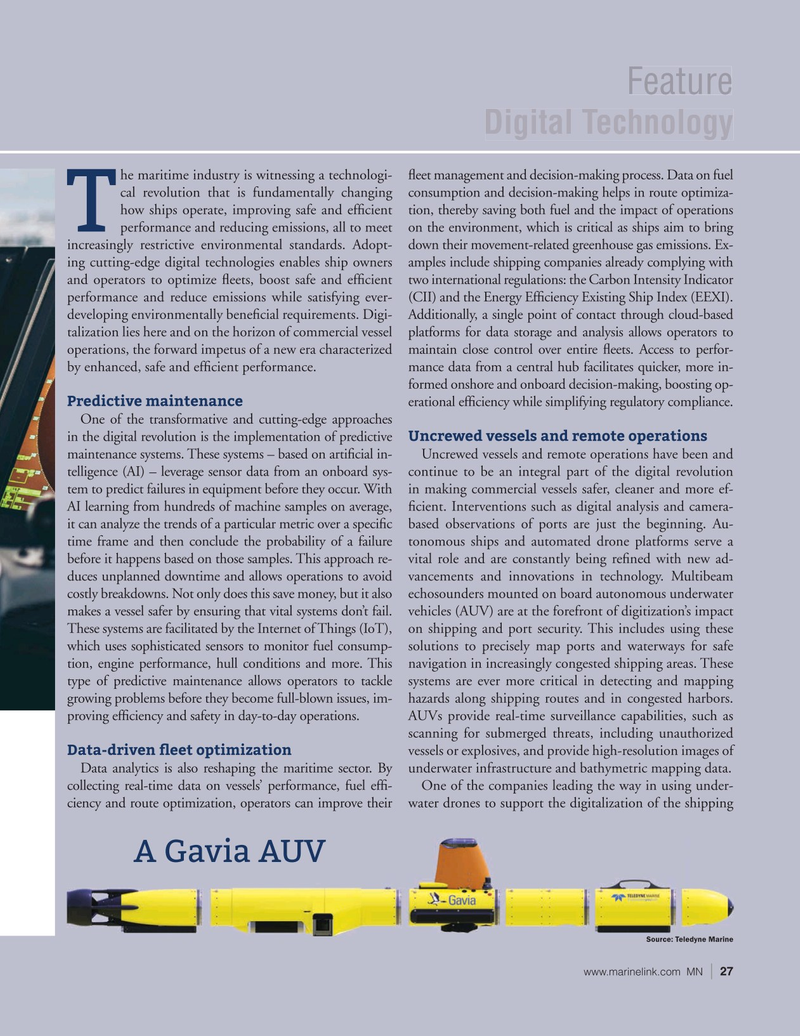
Page 27: of Marine News Magazine (November 2024)
Read this page in Pdf, Flash or Html5 edition of November 2024 Marine News Magazine
Feature
Digital Technology he maritime industry is witnessing a technologi- ? eet management and decision-making process. Data on fuel cal revolution that is fundamentally changing consumption and decision-making helps in route optimiza- how ships operate, improving safe and ef? cient tion, thereby saving both fuel and the impact of operations
T performance and reducing emissions, all to meet on the environment, which is critical as ships aim to bring increasingly restrictive environmental standards. Adopt- down their movement-related greenhouse gas emissions. Ex- ing cutting-edge digital technologies enables ship owners amples include shipping companies already complying with and operators to optimize ? eets, boost safe and ef? cient two international regulations: the Carbon Intensity Indicator performance and reduce emissions while satisfying ever- (CII) and the Energy Ef? ciency Existing Ship Index (EEXI). developing environmentally bene? cial requirements. Digi- Additionally, a single point of contact through cloud-based talization lies here and on the horizon of commercial vessel platforms for data storage and analysis allows operators to operations, the forward impetus of a new era characterized maintain close control over entire ? eets. Access to perfor- by enhanced, safe and ef? cient performance. mance data from a central hub facilitates quicker, more in- formed onshore and onboard decision-making, boosting op-
Predictive maintenance erational ef? ciency while simplifying regulatory compliance.
One of the transformative and cutting-edge approaches in the digital revolution is the implementation of predictive Uncrewed vessels and remote operations maintenance systems. These systems – based on arti? cial in- Uncrewed vessels and remote operations have been and telligence (AI) – leverage sensor data from an onboard sys- continue to be an integral part of the digital revolution tem to predict failures in equipment before they occur. With in making commercial vessels safer, cleaner and more ef-
AI learning from hundreds of machine samples on average, ? cient. Interventions such as digital analysis and camera- it can analyze the trends of a particular metric over a speci? c based observations of ports are just the beginning. Au- time frame and then conclude the probability of a failure tonomous ships and automated drone platforms serve a before it happens based on those samples. This approach re- vital role and are constantly being re? ned with new ad- duces unplanned downtime and allows operations to avoid vancements and innovations in technology. Multibeam costly breakdowns. Not only does this save money, but it also echosounders mounted on board autonomous underwater makes a vessel safer by ensuring that vital systems don’t fail. vehicles (AUV) are at the forefront of digitization’s impact
These systems are facilitated by the Internet of Things (IoT), on shipping and port security. This includes using these which uses sophisticated sensors to monitor fuel consump- solutions to precisely map ports and waterways for safe tion, engine performance, hull conditions and more. This navigation in increasingly congested shipping areas. These type of predictive maintenance allows operators to tackle systems are ever more critical in detecting and mapping growing problems before they become full-blown issues, im- hazards along shipping routes and in congested harbors. proving ef? ciency and safety in day-to-day operations. AUVs provide real-time surveillance capabilities, such as scanning for submerged threats, including unauthorized
Data-driven ? eet optimization vessels or explosives, and provide high-resolution images of
Data analytics is also reshaping the maritime sector. By underwater infrastructure and bathymetric mapping data. collecting real-time data on vessels’ performance, fuel ef? - One of the companies leading the way in using under- ciency and route optimization, operators can improve their water drones to support the digitalization of the shipping
A Gavia AUV
Source: Teledyne Marine www.marinelink.com MN 27|

 26
26

 28
28
